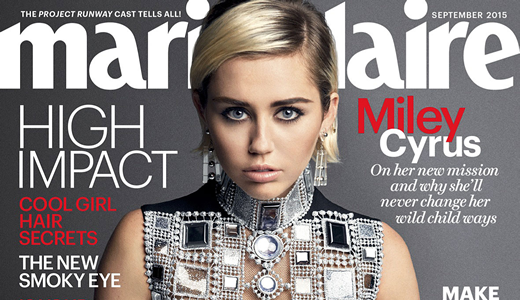We often talk about how pop culture—movies, music, video games, TV, the Internet—influences young people who consume it. But what about those who produce it? Especially if they’re quite young, how does being the at the epicenter of a pop-culture phenomenon influence them?
One supernova star whose influence—for better, for worse—we’ve chronicled over the last decade is Miley Cyrus. And in a recent, wide-ranging cover story interview in the September issue of Marie Claire, Miley talked about how disorienting it was to play the preternaturally perky character Hannah Montana on the hit Disney Channel show of the same name.
Miley wasn’t even a teen when she landed the plum role, one she’d inhabit with magnetic, smiling sassiness from 2006 to 2011. She told Marie Claire, “From the time I was 11, it was, ‘You’re a pop star! That means you have to be blonde, and you have to have long hair, and you have to put on some glittery tight thing.’ Meanwhile, I’m this fragile little girl playing a 16-year-old in a wig and a ton of makeup. It was like Toddlers & Tiaras.”
Miley also said that all the makeup, style and wardrobe changes she had to undergo to become Hannah negatively impacted her body image and even her sense of identity.
I was told for so long what a girl is supposed to be from being on that show,” she said. “I was made to look like someone that I wasn’t, which probably caused some body dysmorphia because I had been made pretty every day for so long, and then when I wasn’t on that show, it was like, Who the f— am I?
In addition, she says that the workload was pretty overwhelming, too. “Every morning, I was getting coffee jammed down my throat to wake me up. I just had to keep going, be tough, be strong. Everything happened to me on that set.”
It was a stressful recipe that eventually yielded significant anxiety. “I would have anxiety attacks. I’d get hot flashes, feel like I was about to pass up or throw up. It would happen a lot before shows, and I’d have to cancel,” she said. “Then the anxiety started coming from anxiety. I would be with my friends, thinking, I should be having so much fun. You get in this hole that seems like you’re never going to be able to get out of.”
There’s a lot worth pondering here. For two decades, Plugged In has talked about the importance of sorting through the messages and images media aims at young people. Among those is the almost unspoken assumption that someone so cheerful, so adorably spunky as Hannah Montana would definitely have it all figured out and be just as grounded in real life.
In fact, perhaps something close to the opposite seems to have been true for Miley. She seems to be saying that she didn’t actually have much in common with the character she played, and that having to bridge that gap came at real cost to her. And if the star of the show struggled with the image she was projecting, how much might the same have been true of the myriad young fans who idolized her?
Miley’s reflections on how a massively successful, career-launching media platform created similarly massive, mostly unseen problems for her is a cautionary tale worth reflecting on with our kids as they begin to identify with any beautiful, vivacious star on TV. Because what our kids’ heroes appear to be on TV may not actually have much to do with who they really are. And that has a lot to do with who our kids perceive themselves to be in relation to the bigger-than-life personas they identify with potentially idolize.
By the way, Jake Roberson, Paul Asay and I will talk more about Hannah Montana and Miley Cyrus on the vodcast tomorrow—delving more deeply into Miley’s experiences and what we can maybe learn from them. Hope you’ll check us out.






Recent Comments